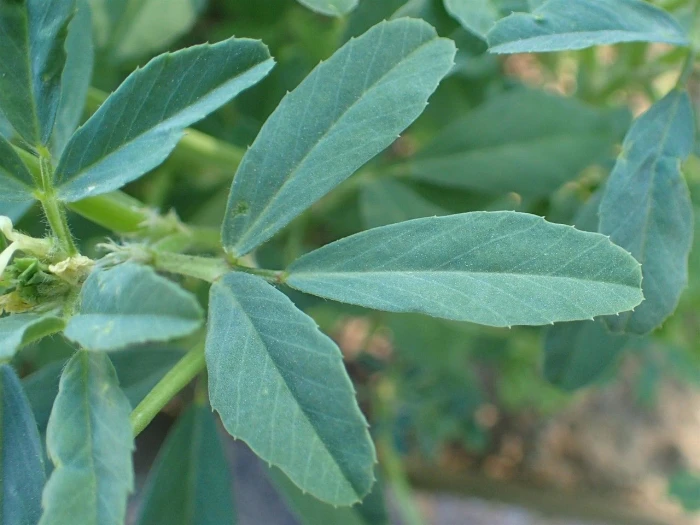Fenugreek
(Trigonella foenum-graecum)
Fenugreek (Trigonella foenum-graecum)
/
/

Yoan MARTIN
CC BY-SA 4.0
Image By:
Yoan MARTIN
Recorded By:
Copyright:
CC BY-SA 4.0
Copyright Notice:
Photo by: Yoan MARTIN | License Type: CC BY-SA 4.0 | License URL: https://creativecommons.org/licenses/by-sa/4.0/ | Attribution: Yoan MARTIN (cc-by-sa) | Rights Holder: Yoan MARTIN | Publisher: PlantNet | Date Created: 2017-06-17T22:00Z | Title: Trigonella foenum-graecum L.: leaf | Notes: |














Estimated Native Range
Climate Requirements for Kowloon, Hong Kong, China
| This Plant | Your Site | Plant Suitability for Your Location | ||
|---|---|---|---|---|
| • Precipitation | 0" - 108" | 90" | Aquatic | Aquatic |
| • High Temp. | 59°F - 114°F | 88°F | Your summer temperatures are normal for this plant. | Excellent |
| • Low Temp. | -2°F - 69°F | 55°F | Your winter temperatures are normal for this plant | Excellent |
This plant may not grow well at your location - your precipitation is too high.
Summary
Trigonella foenum-graecum, commonly known as Fenugreek, is an annual herb native to the Caucasus and Western Asia. It thrives in a variety of habitats including agricultural land, waste areas, and open spaces, indicating its adaptability to disturbed soils. Fenugreek typically grows to a height of 2-3 feet (60-90 cm) and has a unique appearance with light green leaves, small oblong leaflets, and a strong, sweet aroma. Its flowers are small and can range in color from white to yellowish, blooming in the early to mid-summer. The plant is not particularly known for its flowers, as they are not very showy, but rather for its aromatic seeds which are used in cooking and medicine.
Fenugreek is valued for its culinary and medicinal properties, with its seeds being a key spice in curries and its leaves used both fresh and dried in a variety of dishes. It is also known for its potential health benefits, including blood sugar regulation and digestive aid. In cultivation, Fenugreek prefers full sun but can tolerate part shade, and it adapts to a wide range of soil types, provided they are well-drained. It has a relatively low water requirement and can grow in loamy, sandy, or clay soils with varying drainage speeds. While it is generally easy to grow, Fenugreek can suffer from fungal diseases and root rot if overwatered or grown in poorly drained soils. It is not typically grown as an ornamental plant but rather for its seeds and leaves.CC BY-SA 4.0
Fenugreek is valued for its culinary and medicinal properties, with its seeds being a key spice in curries and its leaves used both fresh and dried in a variety of dishes. It is also known for its potential health benefits, including blood sugar regulation and digestive aid. In cultivation, Fenugreek prefers full sun but can tolerate part shade, and it adapts to a wide range of soil types, provided they are well-drained. It has a relatively low water requirement and can grow in loamy, sandy, or clay soils with varying drainage speeds. While it is generally easy to grow, Fenugreek can suffer from fungal diseases and root rot if overwatered or grown in poorly drained soils. It is not typically grown as an ornamental plant but rather for its seeds and leaves.CC BY-SA 4.0
Plant Description
- Plant Type: Herb
- Height: 1-2 feet
- Width: 1-4 feet
- Growth Rate: Rapid
- Flower Color: Yellow, White
- Flowering Season: Summer
- Leaf Retention:
Growth Requirements
- Sun: Full Sun, Part Shade
- Water: Medium
- Drainage: Slow, Medium, Fast
Common Uses
Bank Stabilization, Border Plant, Edible*Disclaimer: Easyscape's listed plant edibility is for informational use. Always verify the safety and proper identification of any plant before consumption., Fragrant, Potted Plant, Rock Garden
Other Names
Common Names: Sicklefruit Fenugreek, Bird’s Foo, Classical Fenugreek, Common Fenugreek, Cultivated Trigonella, Fenugreek, Greek Hay, Greek-Clover, Shembele, Shu-Mo-Sa
Scientific Names: Trigonella foenum-graecum, Trigonella foenum-graceum, Trigonella ensifera, Trigonella graeca, Buceras foenum-graecum, Buceras odoratissima, Fenugraecum officinale, Foenugraecum officinale, Foenugraecum sativum
GBIF Accepted Name: Trigonella foenum-graecum L.